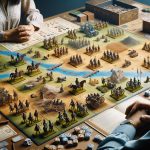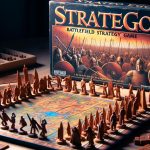The Battlefield Board Game is a popular and immersive strategy game that challenges players to outmaneuver their opponents on a virtual battlefield. With origins dating back to the early days of tabletop gaming, this classic game has evolved over the years to become a staple in the world of board game enthusiasts. In this article, we will explore the essential strategies and tactics for mastering the Battlefield Board Game, from beginner-level tips to advanced gameplay techniques.
To succeed in the Battlefield Board Game, players must carefully consider their movements and plan their actions strategically. From positioning their troops effectively to anticipating their opponent’s next move, every decision can have a significant impact on the outcome of the game. This article will delve into the intricacies of battlefield board game strategy, providing valuable insights for players looking to sharpen their skills and dominate the battleground.
Whether you’re new to the game or seeking to refine your existing tactics, understanding the origins and objectives of the Battlefield Board Game is crucial for honing your gameplay. By delving into key strategies for beginners, intermediate players, and experts alike, we will equip you with a comprehensive toolkit for success on the battlefield.
Additionally, we will explore how customization and adaptability play a vital role in developing an effective board game strategy, ensuring that you can outthink and outmaneuver your opponents at every turn.
Understanding the Battlefield Board Game
The Battlefield Board Game is a strategic war game that challenges players to outmaneuver their opponents on the battlefield. Setting up the game involves laying out the game board, placing troops and resources, and familiarizing oneself with the rules and objectives. The game can typically be played with two or more players, who will take turns executing their strategies to gain control over territories and ultimately achieve victory.
To set up the Battlefield Board Game, start by unfolding the game board and placing it on a flat surface. Each player then chooses a color for their troops and collects the corresponding army pieces. These pieces are then distributed across the territories designated on the board, taking turns until all territories are occupied. In addition to army pieces, players also receive resources such as tanks, aircraft, and naval units to bolster their forces.
Once the game is set up, players can begin strategizing and making their moves. This involves carefully planning troop movements, launching attacks on enemy territories, and defending one’s own positions. Players must also manage their resources efficiently to strengthen their army and expand their influence on the battlefield. Understanding how to navigate these elements effectively is crucial in mastering battlefield board game strategy.
Mastering the Basics
The Battlefield Board Game Strategy is a complex and engaging game that requires players to think critically and strategically in order to achieve victory. For beginners, mastering the basics of the game is essential to build a strong foundation for future success. One key strategy for beginners is to familiarize themselves with the different units and their capabilities. Understanding the strengths and weaknesses of each unit will help players make informed decisions during gameplay.
Another important basic strategy for beginners is to focus on controlling key areas of the game board. By securing strategic locations, players can gain an advantage over their opponents and dictate the flow of the game. It is also crucial for beginners to manage their resources effectively. The game provides players with limited resources, so it is important to prioritize how these resources are allocated in order to maximize their impact on the battlefield.
Additionally, beginners should pay attention to their opponent’s moves and adapt their strategies accordingly. Flexibility and adaptability are crucial components of mastering the Battlefield Board Game Strategy, even at the beginner level. By observing and responding to their opponent’s actions, beginners can learn valuable lessons that will serve them well as they progress through different levels of play.
| Board Game Strategies | Importance |
|---|---|
| Familiarizing with unit capabilities | Understanding strengths and weaknesses |
| Controlling key areas | Gaining advantage over opponents |
| Managing resources effectively | Maximizing impact on the battlefield |
Advanced Tactics
The intermediate level of the Battlefield Board Game is where players start to delve deeper into the various tactics and strategies that can be employed to gain an advantage over their opponents. At this stage, it’s essential to move beyond the basic gameplay mechanics and begin to focus on more advanced tactics that can make a significant difference in the outcome of the game.
Here, we will explore some tips and tricks that intermediate players can incorporate into their gameplay to elevate their skills and competitive edge.
One crucial strategy for intermediate players is to focus on controlling key areas of the game board. By establishing dominance over specific territories or strategic locations, players can influence the flow of the game and limit their opponent’s options. This can be achieved through careful deployment of units, effective positioning, and maintaining a strong presence in critical areas. Controlling these key points will give players a significant advantage in dictating the direction of the game.
Another important aspect of advanced gameplay is understanding when to be aggressive and when to play defensively. Intermediate players should develop a keen sense of when to push forward and apply pressure on their opponents, as well as when to fortify their positions and weather incoming attacks. Balancing offensive and defensive maneuvers is essential for maintaining control over the game board while also keeping opponents on their toes.
In addition, mastering the art of bluffing and misdirection can be a powerful tool for intermediate players. By misleading opponents about your intentions or capabilities, you can manipulate their decision-making processes and create opportunities for yourself. This psychological aspect of gameplay adds another layer of complexity to the battlefield board game strategy, allowing for strategic mind games that can tip the scales in your favor.
| Battlefield Board Game Strategy Tips | Key Takeaways |
|---|---|
| Control Key Areas | Establish dominance over strategic locations |
| Balance Aggression and Defense | Know when to apply pressure and when to fortify positions |
| Master Bluffing Techniques | Utilize misdirection and psychological tactics to outmaneuver opponents |
Going Beyond the Basics
Advanced Unit Placement and Movement
Expert players of the Battlefield board game understand the importance of strategic unit placement and movement on the board. They know how to position their units in a way that maximizes their defensive capabilities while also allowing for effective offensive maneuvers. These players are adept at predicting their opponent’s next moves and adjusting their unit placement accordingly.
Utilizing Special Abilities and Terrain Features
Expert players are well-versed in utilizing the special abilities of different units within the game. They understand how to capitalize on these abilities to gain a tactical advantage over their opponents. Additionally, expert players are highly skilled at using terrain features to their benefit, such as using cover for defensive advantages or positioning units on high ground for better line of sight.
Adapting to Dynamic Game Situations
One hallmark of an expert Battlefield board game player is their ability to adapt to dynamic game situations. Whether it’s a sudden shift in momentum, an unexpected opponent strategy, or a change in the battlefield landscape, expert players can quickly assess the situation and modify their strategy accordingly. Flexibility and adaptability are essential traits for excelling at this level of gameplay.
By mastering these advanced strategies, expert players can elevate their gameplay to new heights, ensuring that they remain competitive and capable of outmaneuvering even the most skilled opponents on the battlefield.
Creating Your Battlefield Board Game Strategy
When it comes to the Battlefield Board Game, there are various strategies and approaches that players can take in order to achieve victory. One key aspect of mastering this game is customizing your approach based on your own play style. Whether you prefer a more aggressive or defensive style of play, tailoring your strategy to fit your strengths can be crucial in achieving success on the battlefield.
To customize your approach, consider the following factors:
- Your preferred type of units: Are you more inclined towards infantry, cavalry, or artillery? Understanding which types of units you excel at using can help shape your overall strategy.
- Personal playing style: Do you tend to be more methodical and strategic, or do you prefer taking risks and making bold moves? Adapting your strategy to align with your natural playing style can greatly impact your performance in the game.
- Preferred game objectives: Some players may prioritize capturing key territories, while others may focus on eliminating their opponent’s forces. Identifying what drives your motivation in the game can influence how you develop and execute your strategy.
By taking these factors into account and customizing your approach accordingly, you can gain a competitive edge on the battlefield and increase your chances of coming out victorious. Remember that flexibility is also important – being able to adjust your strategy as the game unfolds is key to gaining an upper hand over your opponents in this dynamic battlefield board game environment.
Analyzing Key Battlefield Board Game Scenarios
When playing the Battlefield Board Game, it’s essential to be prepared for various game scenarios that may arise. Adapting your strategy based on different game situations can greatly affect the outcome of the game. Whether you’re a beginner, intermediate player, or expert, understanding how to analyze key battlefield board game scenarios is crucial for success.
To adapt your strategy based on different game situations, consider the following tactics:
- Assessing the Initial Game Setup: Take a moment at the beginning of each game to evaluate the initial positions of both your own and your opponent’s pieces on the board. This will give you insights into potential strengths and weaknesses in each player’s position.
- Observing Your Opponent’s Moves: Pay close attention to how your opponent plays their pieces and consider what their potential strategies might be. By observing their moves, you can better anticipate their next steps and adjust your own strategy accordingly.
- Responding to Threats: If your opponent makes a move that threatens one of your key pieces or positions, be ready to adjust your strategy to either defend against this threat or find an alternative approach that neutralizes the risk.
Furthermore, analyzing key battlefield board game scenarios requires flexibility and adaptability. It’s important to remain open-minded and willing to adjust your strategy as the game progresses. By staying adaptable and observant, you can effectively respond to different situations on the battlefield board game and increase your chances of success. Remember that every move matters, and being able to adapt in response to changing circumstances is an essential skill for any battlefield board game strategist.
The Psychology of the Battlefield Board Game
Understanding Your Opponent’s Moves
In the Battlefield Board Game, understanding your opponent’s moves is crucial for developing a winning strategy. Pay close attention to how they position their pieces, the cards they play, and the areas of the battlefield they prioritize. By observing their actions, you can gain valuable insights into their preferred tactics and overall game plan. This information can then be used to anticipate their future moves and formulate counter-strategies.
Adapting Your Strategy Accordingly
Once you have a better understanding of your opponent’s moves, it’s important to adapt your strategy accordingly. This may involve making quick adjustments to your positioning, altering your card plays, or even shifting your focus to different areas of the battlefield. By being flexible and responsive to your opponent’s actions, you can gain a competitive edge and increase your chances of success in the game.
Psychological Mind Games
The Battlefield Board Game also involves a certain level of psychological warfare. By carefully managing your own behavior and responses, you can influence how your opponent plays. For example, bluffing about your intentions or feigning certain weaknesses can lead your opponent into making mistakes or revealing more about their own strategy.
Understanding the psychology of gameplay can give you an advantage that goes beyond just knowing the rules and tactics of the game. Flexibility and adaptability are key elements in mastering the game and winning against opponents at all expertise levels.
Conclusion
In conclusion, the Battlefield Board Game is more than just a game of chance and luck; it requires strategic thinking, adaptability, and flexibility. As highlighted throughout this article, players must understand the origins and objectives of the game, as well as how to set it up and play. Mastering the basics is essential for beginners, but advanced tactics and strategies for intermediate and expert players are equally crucial.
One key takeaway from this discussion is the need for players to customize their approach based on their own play style. There is no one-size-fits-all strategy in the Battlefield Board Game. Instead, successful players must analyze key game scenarios and be able to adapt their strategy accordingly. By understanding the psychology of the game and paying attention to their opponents’ moves, players can adjust their own tactics in response.
Ultimately, flexibility and adaptability are at the heart of mastering the Battlefield Board Game strategy. Whether you are a beginner or an expert player, being able to think on your feet and adjust your approach based on changing circumstances will increase your chances of success.
As with any strategic game, practice makes perfect, so don’t be discouraged by initial setbacks. Keep honing your skills and refining your strategy, and you’ll soon become a formidable player on the battlefield board game landscape.
Frequently Asked Questions
What Is the Trick to Win Battleship?
The trick to win Battleship lies in strategic guessing and deduction. Players need to carefully choose coordinates to target and consider the patterns of their opponent’s ship placements to increase their chances of hitting and sinking ships.
What Is the Most Strategic Board Game Ever?
Many consider chess to be the most strategic board game ever. It requires players to think several moves ahead, anticipate their opponent’s moves, and adapt their strategy accordingly. The combination of tactics and long-term planning makes it a challenging and strategic game.
What’s the Best Way to Arrange Ships in Battleship?
The best way to arrange ships in Battleship is to spread them out across the grid, varying their orientations and distances from each other. This can make it more difficult for the opponent to guess the location of your ships and require them to target a wider area in order to successfully hit them.

I love playing all kinds of games – from classics like Monopoly to modern favourites like Ticket to Ride.
I created this blog as a way to share my love of board games with others, and provide information on the latest releases and news in the industry.





